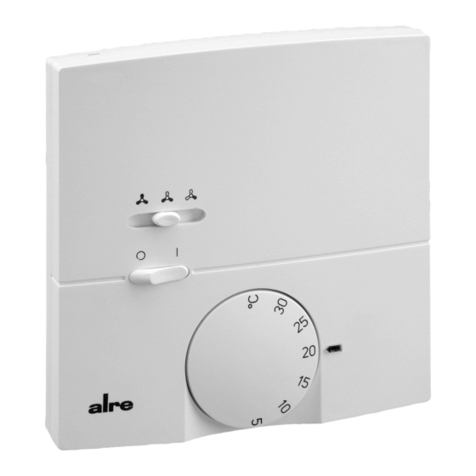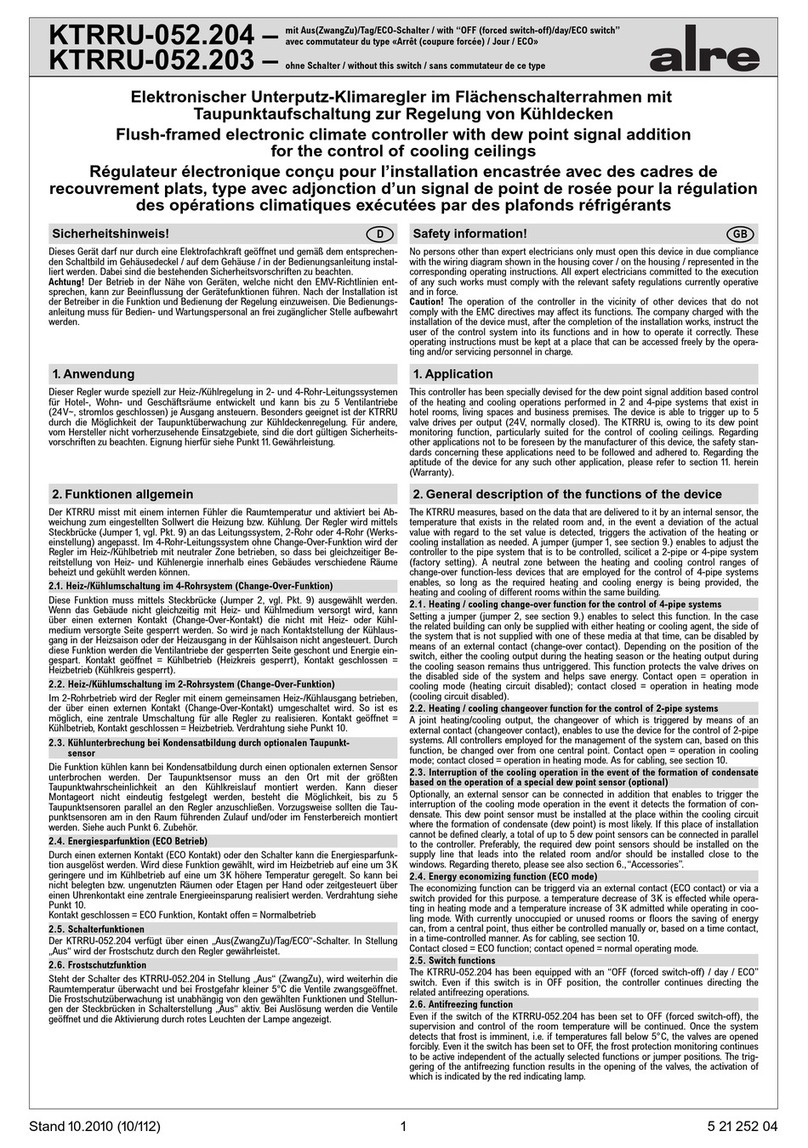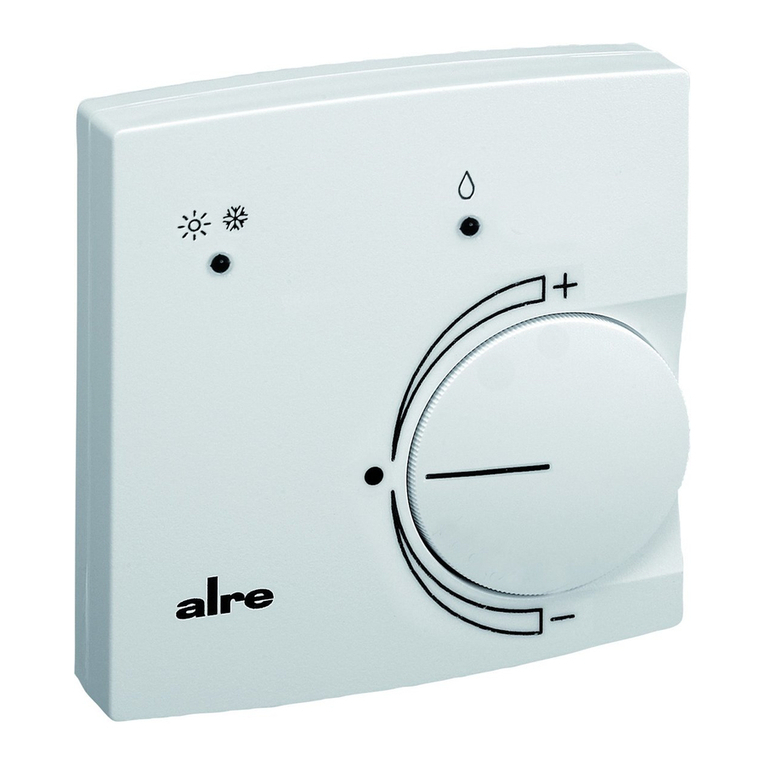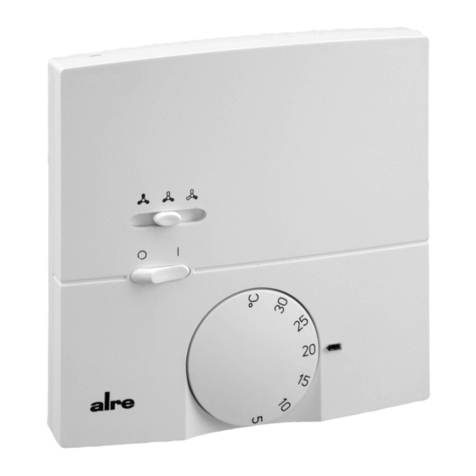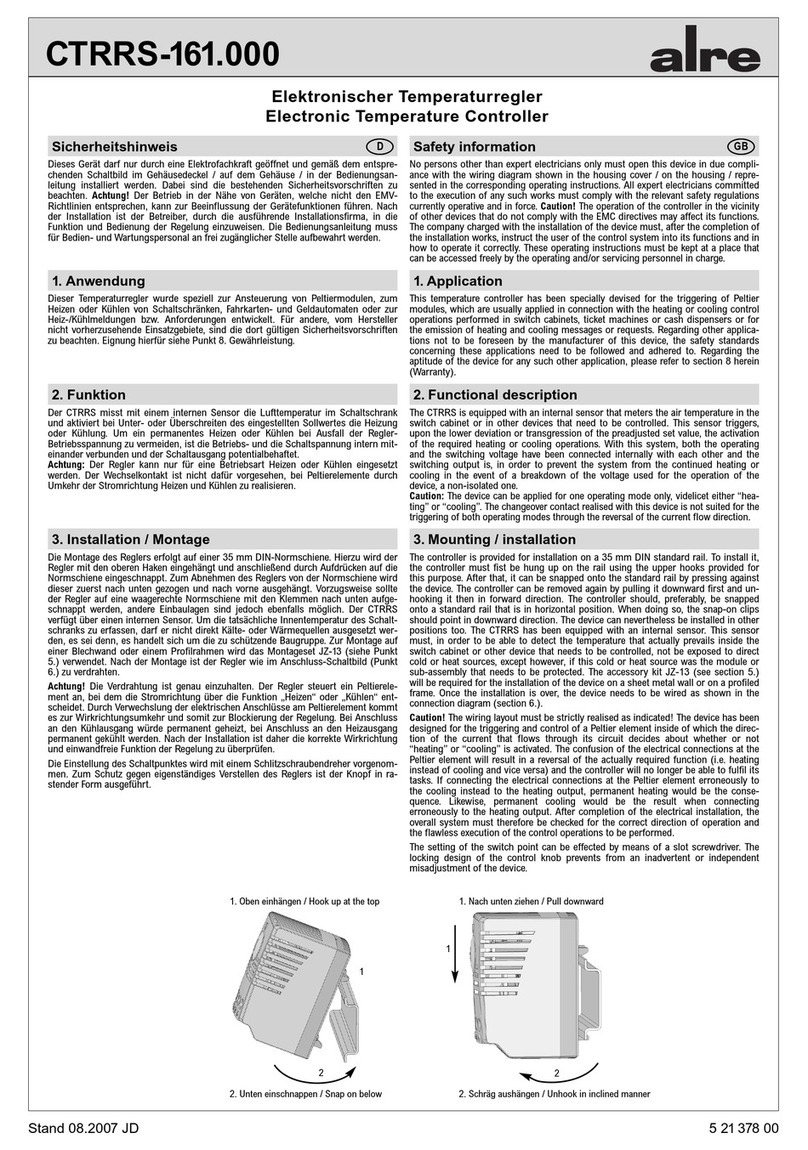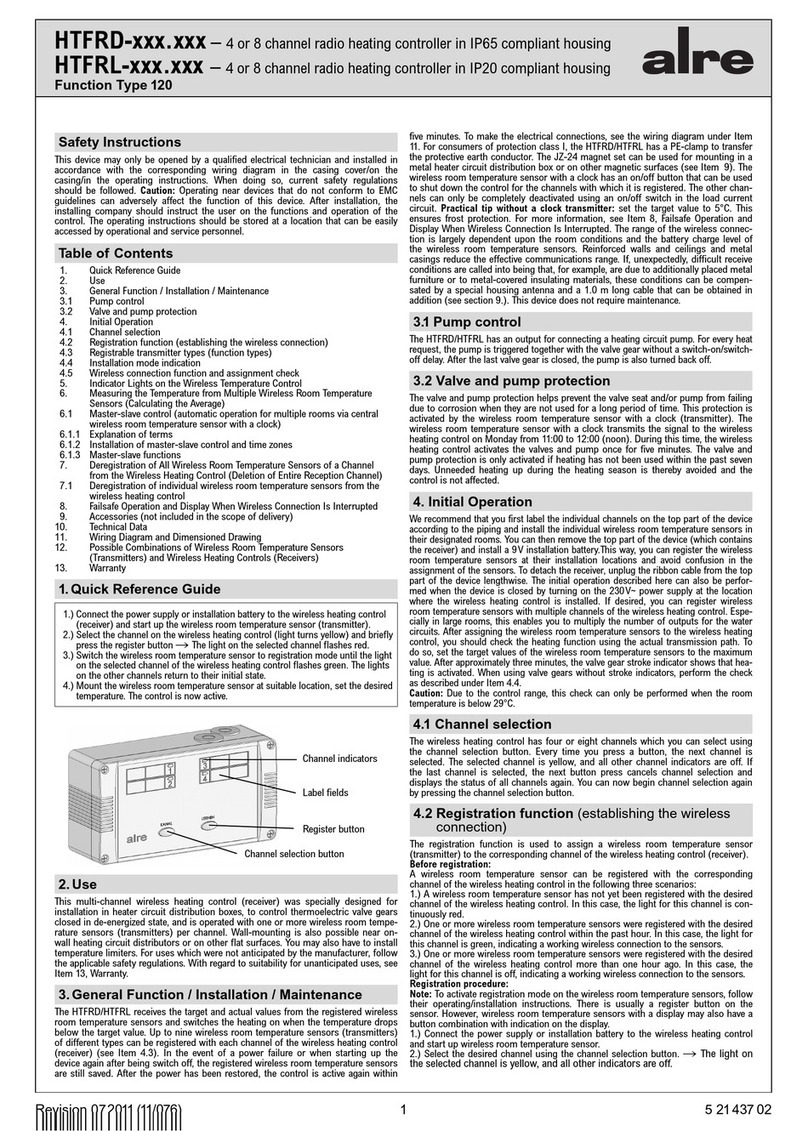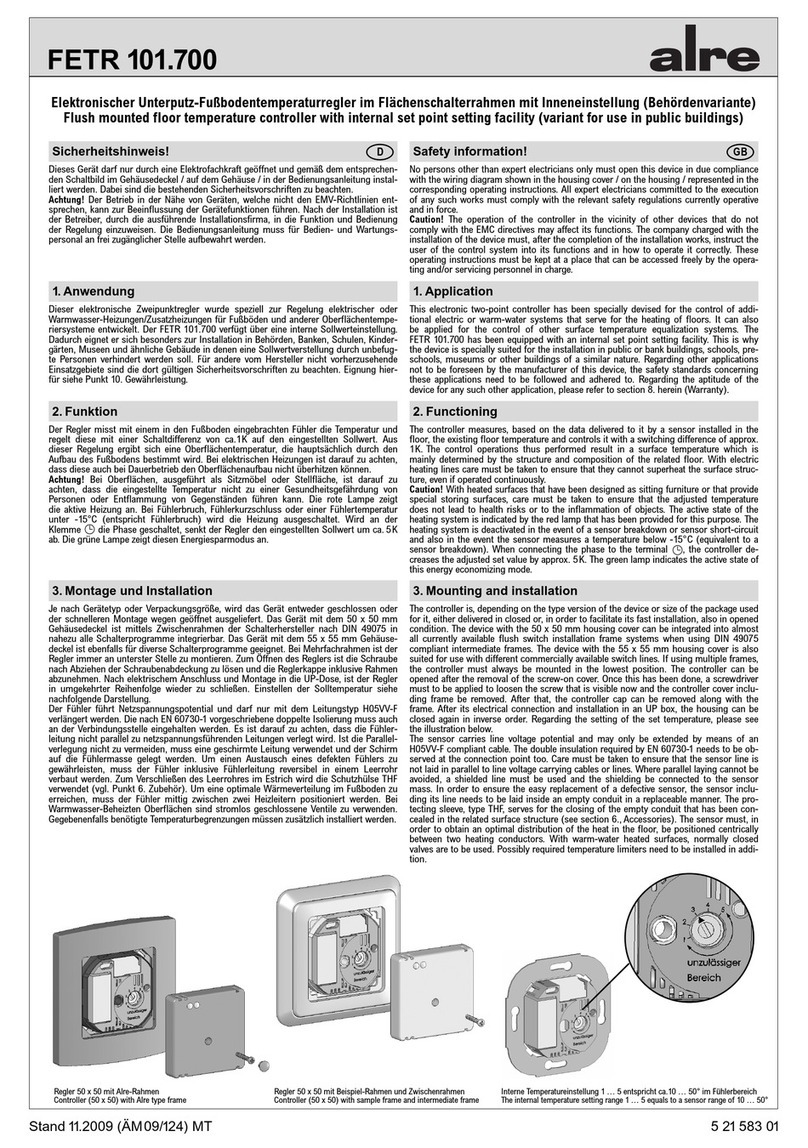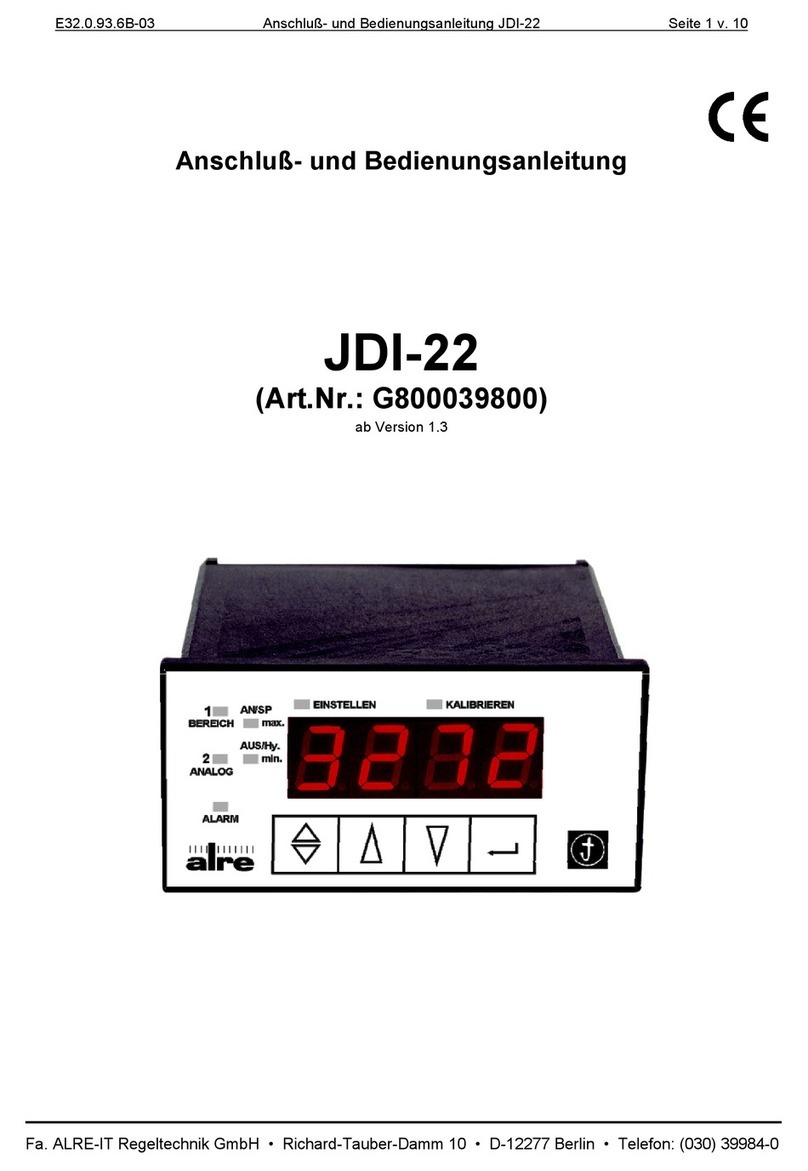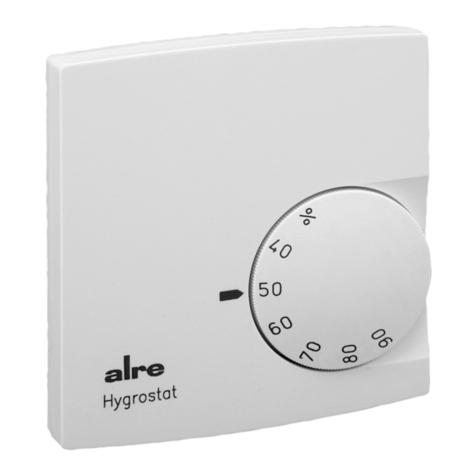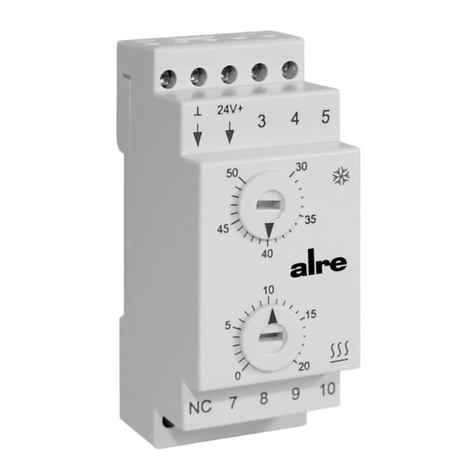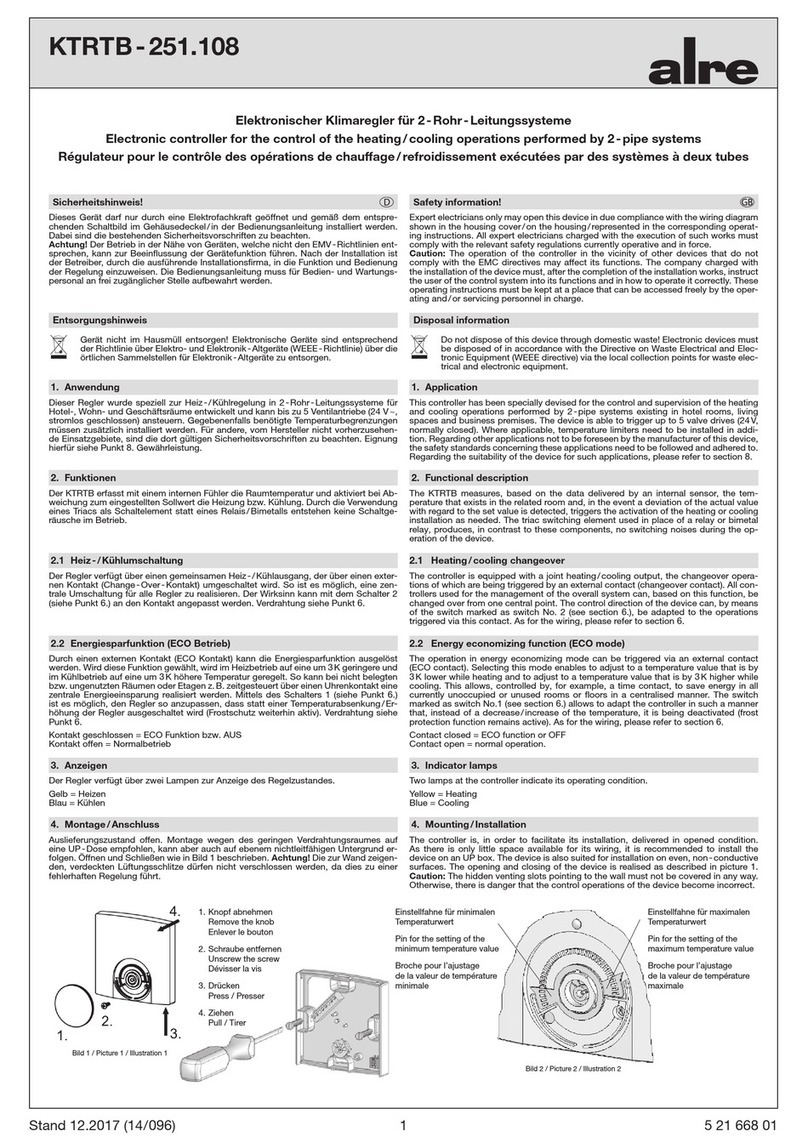
Uniquement des personnes qualifiées en matière d’électricité doivent ouvrir ce dispo-
sitif en conformité avec le schéma des connexions représenté dans le couvercle du boîtier
/ représenté dans les notices d’instructions. Tous électriciens spécialisés chargés de
l’exécution de tels travaux doivent se conformer aux prescriptions de sécurité actuelle-
ment en vigueur s’y rapportant.
Application
KR … Les appareils de la série KR ont été spécialement conçus pour l’utilisation sur le
plan de la technique de chauffage. Ils conviennent pour être utilisés dans des chaudières,
accumulateurs thermiques, sous-stations pour le chauffage urbain et dans des installa-
tions thermoconductrices.
LR … Les appareils de la série LR, par contre, ont été conçus pour des tâches spéci-
fiques sur le plan de la technique de ventilation, comme p. ex. en tant que limiteurs de
corps de chauffe électriques ou pour la surveillance de l’alimentation en air.
Fonctionnement
STB (limiteur de température de sécurité) / réglage interne; réinitialisation interne
TB/TR/TW: La valeur de température de consigne préréglée une fois atteinte, le capteur
capillaire déclenche un microcommuatateur et le contact de chauffage 1-2 s’ouvre. Le
circuit de chauffage sera mis hors de circuit. Le contact de refroidissement 1-3 se ferme
et est actif.
STB: La valeur limite de température une fois atteinte, le contact de chauffage 1-2
s’ouvre. Le circuit de chauffage sera mis hors de circuit. Le contact de signal 1-3 se
ferme est actif. Avec des types munis d’une lampe de signalisation, cette lampe s’allume.
Le limiteur de température de sécurité (STB) sera débloqué si la température tombe, par
une valeur dans une plage approximative allant de 20 à 25K, au-desssous de la valeur
limite de température.
Caractéristiques techniques
Plage de réglage TR/TW: voir plaque signalétique
Température de coupure TB: réglable (voir plaque signalétique)
Température de coupure STB: fixed, either 75°C or 100°C (see reating plate)
Différentiel de coupure:
TR/TW: voir plaque signalétique
TB: réinitialisation manuelle après refroidissement par au
moins 8K
STB: réinitialisation manuelle après refroidissement par au
moins 20K
Pouvoir de coupure:
TR/TW/TB: 15(8)A 24 - 250V~, bei 24V~ min.150mA
STB: Contact de chauffage 1-2: 16(4)A, 24 - 250V~;
min. 500mA à 24V~;
contact de signal 1-3: max. 500mA, 250V~;
min. 500mA à 24V~;
Attention: En cas de l’utilisation d’un contact TR en
combinaison avec un limiteur de température de sécurité
(STB), veuillez consulter les caractéristiques techniques
concernant le STB pour obtenir plus d’informations
quant au pouvoir de copure du contact de chauffage;
quant au povouir de coupure du contact de refroidisse
ment, veuillez consulter les caractéristiques techniques
concernant le contact de signalisation du STB.
Section de raccordement: 1,0 … 2,5 mm2
Type de contact: TW = type 2.B
TB = type 2.B.H.V
TR = type 1.B
STB = type 2.B.H.K.P.V
Type de protection: IP43 / en option IP54
Température admissible au
niveau de la tête du régulateur: max. 80°C
Température max. admise sur
le capteur
TR/TW/TB : pleine échelle +15%
STB : 135°C
Constante de temps: env. 50 sec. (avec tube
plongeur dans l’eau agitée)
Contacts: inverseur libre de potentiel
Matériel du bulbe et des tubes
capillaires: cuivre (Cu)
Tube plongeur: en laiton nickelé ou en V4A
Hélice de protection: en acier nickelé
Questo apparecchio deve essere aperto unicamente da elettricisti qualificati ed installato
in base allo schema di collegamento riportato nel coperchio della scatola / nelle istruzioni
per l’uso. Allo scopo si raccomanda di osservare le norme di sicurezza in vigore.
Applicazione
KR … Gli apparecchi della serie KR sono concepiti specialmente per l
’
impiego nel campo
della tecnica di riscaldamento in caldaie o accumulatori termici, centrali termiche ed impi-
anti termoconduttori.
LR … Gli apparecchi della serie LR, invece, sono stati concepiti per impieghi specifici nel
settore della tecnica di ventilazione, come ad es. limitatori di corpi elettrici di riscalda-
mento o controlli dell’alimentazione aria.
Funzionamento dell’apparecchio
STB (limitatore temperatura di sicurezza) / regolazione interna; reset interno
TB/TR/TW: Una volta raggiunto il valore della temperatura nominale impostato, il capil-
lare attiva un microinterruttore e il contatto di riscaldamento 1-2 si apre. Il circuito di
riscaldamento viene disattivato. Il contatto di raffreddamento 1-3 chiude e resta attivato.
STB: Una volta raggiunto li valore limite della temperatura, il contatto di riscaldamen-
to 1-2 si apre. Il circuito di riscaldamento viene disattivato. Il contatto del segnale 1-3
chiude e resta attivato. Con i tipi provvisti di spia di segnalazione la spia si accende. Se
il valore limite della temperatura si abbassa per ca. 20-25K il limitatore STB può essere
sbloccato.
Dati tecnici
Campo di regolazione TR/TW: vedi targhetta dati
Temperatura di rottura TB: regolabile (vedi targhetta dati)
Temperatura di rottura STB: fissa 75°C o 100°C (vedi targhetta dati)
Differenziale di rottura
TR/TW: vedi targhetta dati
TB: reset manuale dopo raffreddamento per almeno 8K
STB: reset manuale dopo raffreddamento per almeno 20K
Potenza di rottura
TR/TW/TB: 15(8)A 24 - 250V~, bei 24V~ min.150mA
STB: Contatto di riscaldamento
1-2 16(4)A 24 - 250V~, 24V~ min. 500mA
Contatto di segnale
1-3 max. 500mA, 250V~, 24V~ min. 500mA
Attenzione! A seguito di contatto TR in combinazione
con un limitatore di temperatura di sicurezza (STB)
consultare le caratteristiche tecniche su STB per ricavare
maggiori informazioni sulla potenza di rottura del
contatto di riscaldamento; relativamente alla potenza di
rottura del contatto di raffreddamento consultare le
caratteristiche tecniche sul contatto di segnalazione del
limitatore STB.
Sezione di raccordo: 1,0 … 2,5 mm2
Tipo contatto: TW = Tipo 2.B
TB = Tipo 2.B.H.V
TR = Tipo 1.B
STB = Tipo 2.B.H.K.P.V
Tipo protezione: IP43 / optional IP54
Temperatura max. ammessa
a livello testa rivelatore: 80°C
Temperatura max. su sensore
TR/TW/TB: valore campo scala +15%
STB: 135°C
Costante tempo: ca. 50 sec. (con tubo
pescante in acqua mossa)
Contatti: inversore a potenziale zero
Bulbi e capillari: rame (Cu)
Tubo pescante: ottone nichelato o V4A
Elica di protezione: acciaio nichelato
Consigne de danger! FAvviso di pericolo I
2
Conditions de montage
Avec tous types de régulateurs extérieurement réglables, il faut d’abord enlever le bouton
de réglage. La partie supérieure peut maintenant être dévissée pour permettre le monta-
ge de l’appareil. En cas de l’utilisation d’un double-régulateur de ventilation en combinai-
son avec un limiteur de température de sécurité (STB), uniquement la borne à souder à
l’STB prévue à cet effet (voir chapitre «Dessins cotés») doit être utilisée pour le raccor-
dement du conducteur de protection (PE). La précision de commutation ne peut être as-
surée que si le médium dans lequel il est immergé circule librement tout autour du tube
de protection. Un ressort de pression dans le tube de protection appuie le capteur contre
la paroi du tube. Ce ressort est un élément absolument essentiel, parce qu’il garantit une
réponse rapide du régulateur en un minimum de temps. Insérez le capteur manuellement
dans le tube plongeur de protection de telle manière à ce que le tube capillaire ne soit
pas plié. La tête du régulateur, une fois serrée sur le tube plongeur de protection, peut
être fixée au moyen des vis pévues dans le boîtier à cet effet. Les régulateurs de ventila-
tion de la série LR… sont munis d’une bride et d’une hélice de protection pour le monta-
ge direct dans des conduits d’air. Le régulateur lui-même peut être monté après coup.
Condizioni di montaggio
Per tipi di regolatori regolabili esternamente togliere prima il pulsante di regolazione ter-
mica, prima di svitare la parte superiore per l’installazione. Se viene usato un regolatore
doppio di ventilazione in combinazione con un limitatore STB il collegamento PE avvie-
ne esclusivamente tramite il morsetto saldato sul limitatore STB (vedi capitolo “Disegni
quotati”). La circolazione del liquido intorno al tubo protettivo è assolutamente importan-
te per la precisione di commutazione. Il tubo protettivo deve essere lambito dal liquido
per l’intera lunghezza. Nel tubo protettivo è integrata una molla, che sospinge il sensore
sulla parete interna del tubo protettivo. Solo tramite questa molla è possibile garantire
una reazione rapida del regolatore. Sospingere il sensore direttamente con la mano nel
tubo protettivo, senza far piegare il tubo capillare. Il fissaggio della testa regolatore ha
luogo con le viti disponibili nella scatola, che dovranno essere serrate sul tubo protettivo.
Il regolatore di ventilazione LR… è provvisto di flangia con elica protettiva per il fissag-
gio diretto nel canale dell’aria. Il regolatore stesso può essere montato in un momento
successivo.
